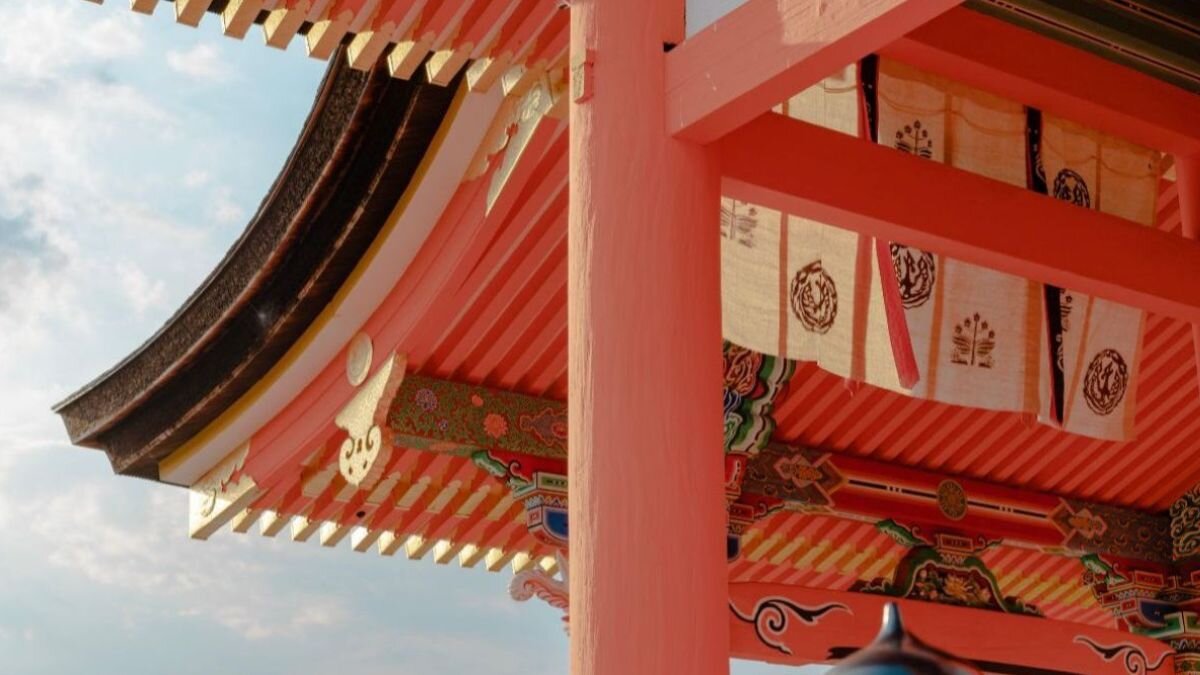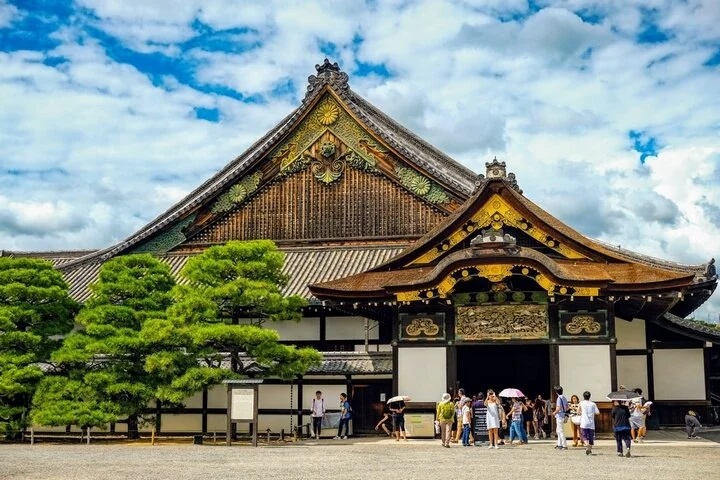popular sights in kyoto
Kyoto @ Su San Lee, Unsplash
Looking for a particular topic? Jump down from the links below:
POPULAR SIGHTS
Kyoto offers lots of interesting locations and sights to visit! Below you can find some of our recommendations to explore during your stay.
Famous landmarks & areas
Kyoto Tower @ Suttawee Tantiwongchai, Unsplash
Kyoto Tower
The Kyoto tower is the tallest structure in Kyoto with 131 meters of height. The tower built in 1964 is an iconic and modern landmark in the ancient capital. Visitors can access the viewing platform 100 meters above ground, which offers a 360 degree view of Kyoto. On clear days, you can see Osaka as well. On the bottom of the commercial building of which the tower sits on top of, you can find restaurants and souvenir shops to explore.
Nijo Castle
Built in 1603 to be the residence of Tokugawa Ieyasu is now available to be enjoyed by everyone. Explore the ancient gardens and wide moats that used to protect the Shogun. The castle is known for its nightingale floors that squeak when stepped on to alert intruders. The castle also has masterful pieces of painted works, most notably the painted screens within the main chamber.
Kyoto Imperial Palace
The Kyoto Imperial Palace used to be the residence of the Imperial Family of Japan until 1868, when the emperor and capital were moved to Tokyo. The palace is located in Kyoto Imperial Park, which is a spacious and beautiful park in the center of Kyoto.
Nishiki Market
Nishiki Market is also known as Kyoto’s Kitchen, which is a traditional market district home to all kinds of seafood and cookware and is a great spot to try some of Kyoto’s seasonal specialties. Although some newer stores have moved in, the shopping street still has many traditional stores that keep the essence of the traditional atmosphere that gives guests a peek into what an actual old market district used to be like.
Gion Walk
Immerse yourself in traditional Kyoto and walk through one of the most mesmerizing districts of Japan. As you explore Gion, let yourself get lost amongst the stunning shrines, temples and beautifully preserved streets. Enjoy the sight of traditional buildings and watch the geisha and maiko in the meeting places.
Ninomaru Palace in the Nijo Castle area @ Eleonora Albasi, Unsplash
Sights surrounded by nature
Arashiyama Bamboo Forest
Transport yourself to a world of stunning scenery. Arashiyama is an iconic attraction for its illustrious bamboo groves and serene beauty. The area is most popular during spring for its lovely cherry blossoms and during fall for its vibrant warm colors, but nonetheless, the area is absolutely breathtaking all year round. Lose yourself in the variety of small shops and attractions, including the picturesque Togetsukyo Bridge and impressive Tenryuji Temple.
Katsura Imperial Villa
Among one of the four imperial properties in Kyoto, Katsura Imperial Villa is one of Japan's most important large-scale cultural treasures. Considered a masterpiece of Japanese gardening, the villa is surrounded by fine gardens that guests can stroll through at leisure. The building is also considered one of the greatest achievements of Japanese architecture and includes a drawing room and tea house.
Arashiyama Bamboo Forest @ TOKI
Japanese macaques at Iwatayama Monkey Park @ Guy Barzilay, Unsplash
Philosopher’s Path
The Philosopher's Path is a stone path leading through the northern part of Higashiyama district in Kyoto. It is one of the most popular spots for cherry blossom viewing, as the path follows a canal lined by hundreds of cherry trees. The about two kilometers long path begins from the Ginkakuji (the Silver Pavilion) area and ends in the neighborhood of Nanzenji.
Monkey Park Iwatayama
The monkey park, located in Arashiyama, has over 120 snow monkeys, which is native species in Japan. The visitors can see the monkeys that are also called “Japanese macaque” running and swinging around the park freely. The park is located on top of a mountain, so you’ll need to hike it up for about 30 minutes. In spring, the hiking trail is full of beautiful cherry blossom trees, and during autumn the visitors can admire the colorful autumn leaves.
Kyoto Botanical Garden
The Kyoto Botanical Garden is Japan’s oldest and most comprehensive public botanical garden. The garden founded in 1924 is around 240,000 square meters, and has around 12,000 different species of plants. There are several areas to explore, such as bamboo garden, hydrangea garden, lotus pond, Japanese iris garden, peony garden, and plum grove. The area is great for strolling around and enjoying nature, stopping for a picnic, or viewing the cherry blossoms in spring.
Kyoto Garden Tour
Are you interested in Japanese horticulture, gardening and landscape architecture? TOKI has prepared a wonderful experience of a private garden tour, during which you will visit some of Japan’s most exclusive gardens and taking a journey through Japanese history, philosophy, and seasonal aesthetics of the quintessential Japanese garden! The experience is held in cooperation with several members of the family that takes care of the most important gardens in Kyoto, including the Imperial Park Ryoanji, the Hyatt Regency, and the Kyoto Hotel. Read more about this experience perfect for those who love nature and peaceful outdoor spaces here.
Beautiful temples & shrines:
Kinkaku-ji Temple @ TOKI
Kinkaku-ji
Kyoto's Golden Pavilion is unmatched in its beauty and one of the most iconic temples in Japan and recognized as a UNESCO World Heritage Site. Surrounded by beautiful gardens and reflected in the mirror pond, Kinkakuji is a sight to behold all year round however it is particularly gorgeous when the roof is blanketed by snow.
Ginkaku-ji
Closely related to Kinkakuji, Ginkakuji is surrounded by unique Japanese gardens and now stands within as a Zen temple. Journey through the different gardens to the main hall which displays paintings on it's sliding doors. From the moss garden guests are able to see scenic views of the temple and city beyond.
Nanzen-ji
Nanzen-ji, one of the most important Zen temples in all Japan, is located at the base of the Higashiyama mountains in Kyoto. It is the head temple of one school of the Rinzai sect of Japanese Zen Buddhism. Nanzen-ji includes many sub-temples and a great number of other miscellaneous structures. The three main sights of the location are the 22 meters tall Sanmon Gate, the Hojo Teien garden, and the Nanzen-in sub-temple.
Higashi and Nishi-Honganji
If Kinkaku-ji and Ginkaku-ji are the glamorous, gilded siblings, then the Honganjis are the imposing, hulkish brothers whose very presence is inspiring. They are both known for their beautiful lanterns, wide terraces, and peaceful praying spots.
Kiyomizu-dera
The Kiyomizu temple is not only a UNESCO World Heritage Site, but also a finalist for the new Seven Wonders of the World. The temple sits atop a hill giving spectacular views of Kyoto. Making your way up to the temple is also a journey in itself not to be missed, as Ninenzaka and Sannenzaka feature shops that sell traditional and handmade goods as well as Kyoto specialities.
Sanjusangendo Temple
This temple is known for its 1001 statues of Kannon, the Goddess of Mercy. Measuring 120 meters, the temple hall is Japan's longest wooden structure. The name Sanjusangendo (literally "33 intervals") derives from the number of intervals between the building's support columns, a traditional method of measuring the size of a building.
Tenryuji Temple
Kyoto’s Tenryuji Temple is the main temple of the Rinzai school and one of the five main zen temples in Kyoto. Sitting within the forests of Arashiyama, guests are able to enjoy the scenic mountain views surrounding the temple. Built in 1339, the Tenryuji Temple has lost many buildings in fires but the zen gardens have been preserved since the 14th century.
Fushimi-Inari Shrine path @ Lin Mei, Unsplash
Fushimi-Inari Shrine
Journey through the gates of mystique on this pathway of the gods. This shrine is known for its long paths completely covered by red “torii” gates. The magical, seemingly unending path of over 5000 vibrant orange torii gates that wind through the hills behind Fushimi Inari-taisha Shrine makes it one of the most popular shrines in Japan.
Saihoji Temple
Said to have been established in the Nara period, this “moss” temple is known for its stunningly refreshing moss garden. It is estimated to have 120 different types of moss within its beautiful Japanese garden architecture. Guests are asked to participate in meditation before entering the garden grounds.
Toji Temple
Among one of many of Kyoto’s ancient temples, Toji Temple offers the spectacular 5 story pagoda which is a symbol of Kyoto. Some buildings within the grounds of Toji Temple are considered national treasures. Walking through the temple grounds will take you to the ancient city that Kyoto once was. An antique fair happens on the 21st of each month at Toji temple and transforms the temple grounds into a lively market.
Daitokuji Temple
Established in 1326 and known for its connection with Sen no Rikyu, Daitokuji Temple is a massive Zen Buddhist Temple complex. Within the complex, you can find a variety of zen gardens and temples that pay homage to the Japanese aesthetic. Sen No Rikyu is one of the primary contributors to the tea ceremony that we know today. The main buildings are surrounded by smaller temples added by feudal lords and a few of these sub-temples are open to viewing.
Byodoin Temple
Beautiful during any time of year, Byodoin Temple is well known throughout Japan and its depiction is even on the 10 yen coin. Explore this otherworldly temple and scenic gardens before going underground where the temple hides its national treasures within its museum of 1000-year-old beauty.
Sanjusangendo Temple
Known for its 1001 statues of Kannon, the goddess of mercy. Measuring 120 meters, the temple hall is Japan's longest wooden structure. The name Sanjusangendo (literally "33 intervals") derives from the number of intervals between the building's support columns, a traditional method of measuring the size of a building.
Shoren-in Temple
Get lost in the atmosphere of this gorgeous temple that has been closely related to the imperial family for centuries. Since it was built as a villa instead of a temple, the grounds are very different from your normal temple. Stroll through the tranquil gardens that surround a koi pond and marvel at the traditional Japanese architecture of the temple itself.
Ginkaku-ji Temple @ David Klein, Unsplash
Byodoin Temple @ jc3211, Unsplash
Related Articles













